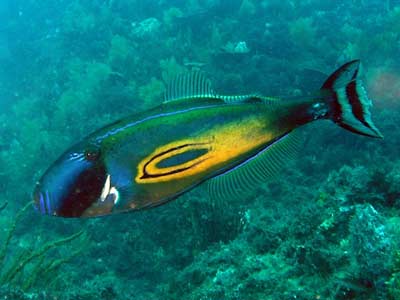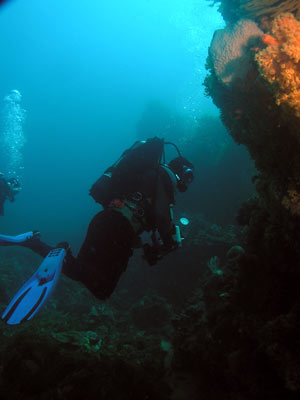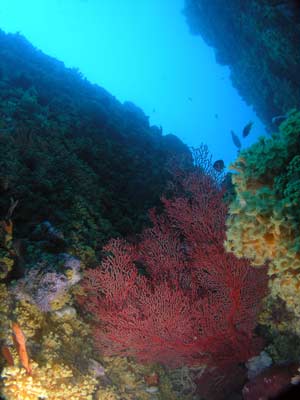|
The Northern Coastline of Tasmania is quite spectacular is spots and there are a number of places that you can dive. The Rocky Cape area, located between Stanley and Wynyard, has sites right around the cape as well as further east near Sisters Beach.
At Sisters Beach there are many different dive sites. Most of these are located around Sisters Island or the rocks between the island and the shoreline. This island is off the eastern end of Sisters Beach.
 |  |
| This is not a Six-spined leatherjacket, but very similar | A typical section of the reef |
To do this spot, you normally launch your boat at the Sisters Beach boat ramp or you could come from the boat ramp at Boat Harbour further to the east. It is a short three kilometre run from the Sisters Beach ramp to Sisters Island. This is a small rock that juts a little out of the water.
A good spot to dive is off the north-eastern corner of the island at GPS Reading S40° 54' 02.5" E145° 34' 55.4". This is using WGS84, unlike most of my diving GPS Marks on this web site. If you do not know what this means, read my GPS Page.
Most diving in Tasmania is not done by anchoring. People seem to either do a live drop or use a small anchor and buoy, dropping divers next to the buoy. The boat then waits for you and picks you up as you surface. I have no idea why this happens, as there does not seem to me to be any advantage overing anchoring like we do in Sydney.
 |  |
| Yellow bryozoans are all over the place | A very nice gorgonia in a crack |
 |
| A yellow sea spider on this reef |
Anyway, once at the above location, either anchor or drop your buoy. When you enter the water, the depth will be about seven metres on the top of the bommie. There are a series of gutters that run north-south. A deeper section of the reef is at 20 metres and it then slopes to 24 metres.
There are a few overhangs and holes. The reef is mostly covered with kelp. This is much larger than the kelp we get in NSW, perhaps 1.5 to 2 metres high. The rocks have a few sponges, very colourful and some small lace corals. There are a few gorgonias, a couple are quite large (see the accompanying photographs). There are lots of yellow bryozoans.
Fish we saw included red morwong, mosaic leatherjackets, six-spined leatherjackets, seapike (that looked to me like a barracuda) and a wrasse that I at first thought was a crimson-banded wrasse, but I now know is a xxx wrasse.
There were also some yellow colour sea spiders, tiny, about 20 mm across. These were hard to find in the yellow kelp, but made excellent subjects for photos.
We did a bottom time of about 33 minutes before gradually ascending to the top of the bommie over the next seven minutes. We did another five minutes safety stop on the top of the bommie before exiting the water.
This was a very good dive site. I dived here in February 2008 and we had 20 metre visibility and water temperature of 19ÂșC.
The dive shop at Wynyard probably runs out to this location.
| 
 v6.00.307 © 2003-2005
v6.00.307 © 2003-2005